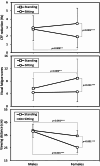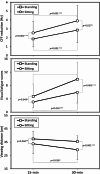Eyestrains among smartphone users while watching videos in Taipei MRT carriages: a comparison between sitting and standing postures
- PMID: 39455725
- PMCID: PMC11511868
- DOI: 10.1038/s41598-024-76334-9
Eyestrains among smartphone users while watching videos in Taipei MRT carriages: a comparison between sitting and standing postures
Abstract
In MRT carriages, more passengers are watching videos on their smartphones during daily commutes, yet the impact of these viewing conditions on visual strain remains unexplored. This study examined eyestrain in 24 male and 24 female participants while watching videos on smartphones in two postures (sitting and standing) and over two durations (15 min and 30 min) in Taipei MRT carriages. We measured critical flicker fusion frequency (CFF) reduction, visual fatigue scale (VFS) scores, and viewing distance (VD) for each trial. Results revealed significant effects of sex, posture, and viewing duration on visual strain, with notable two-way interactions (sex × posture and posture × time) influencing most outcomes. Women showed greater CFF reduction while sitting compared to standing (3.47 Hz vs. 1.90 Hz, p < 0.001) and maintained shorter VDs while seated (25.5 cm vs. 34.3 cm, p < 0.001). However, they reported higher VFS scores when standing (8.94 vs. 4.60, p < 0.001), indicating increased discomfort while standing in the moving MRT carriage. Men exhibited higher CFF reduction (2.81 Hz) than women while standing (1.90 Hz) (p < 0.01), but this difference was not observed while sitting. Eyestrain indicators significantly worsened after 30 min of viewing compared to 15 min, with stronger effects on VFS scores and VDs. This finding supports the recommendation to take breaks after 20 min of smartphone use, even in MRT carriages. Although subjective eyestrain is not always recognized, watching videos on smartphones while seated can result in unexpectedly high levels of objective visual fatigue, indicated by CFF reduction. Our findings suggest that eyestrain patterns in MRT carriages differ from those reported in previous studies. Seated passengers, particularly females with shorter VD, may experience unrecognized eyestrain that could impact eye health, while standing passengers may face greater discomfort. These results highlight the need for increased awareness and preventive measures to mitigate eyestrain in digital public transportation environments.
Keywords: Critical flicker fusion frequency (CFF); Eyestrain; MRT carriages; Smartphone use; Viewing distance; Visual fatigue scale (VFS).
© 2024. The Author(s).
Conflict of interest statement
The authors declare no competing interests.
Figures


References
-
- Mushroor, S., Haque, S. & Riyadh, A. A. The impact of smart phones and mobile devices on human health and life. Int. J. Community Med. Public Health7, 9–15 (2020).
-
- Priya, D. B. & Subramaniyam, M. Fatigue due to smartphone use? Investigating research trends and methods for analysing fatigue caused by extensive smartphone usage: A review. Work72, 637–650 (2022). - PubMed
-
- Digital. Taiwan, https://datareportal.com/reports/digital-2023-taiwan, 2023 (assessed on 20 July 2024).
Publication types
MeSH terms
Grants and funding
LinkOut - more resources
Full Text Sources

